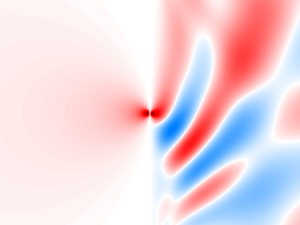Published online by Cambridge University Press: 20 May 2021

Hill's vortex is a classical solution of the incompressible Euler equations which consists of an axisymmetric spherical region of constant vorticity matched to an irrotational external flow. This solution has been shown to be a member of a one-parameter family of steady vortex rings and as such is commonly used as a simple analytic model for a vortex ring. Here, we model the decay of a Hill's vortex in a weakly rotating flow due to the radiation of inertial waves. We derive analytic results for the modification of the vortex structure by rotational effects and the generated wave field using an asymptotic approach where the rotation rate, or inverse Rossby number, is taken to be small. Using this model, we predict the decay of the vortex speed and radius by combining the flux of vortex energy to the wave field with the conservation of peak vorticity. We test our results against numerical simulations of the full axisymmetric Navier–Stokes equations.